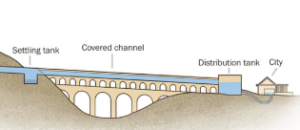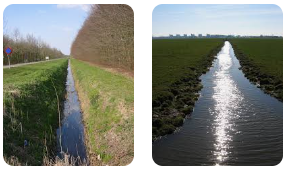A stream in geology refers to a body of water that flows on the Earth’s surface, typically in a channel with defined banks. A water channel is known to be a stream if it has the following features;
- Flow: Streams have a continuous flow of water, usually moving downhill due to gravity.
- Size: They can range from small creeks to large rivers.
- Channel: Streams flow in a defined path called a channel, which can be straight or meandering.
- Erosion and deposition: Streams shape the landscape through erosion, transportation, and deposition of sediments.
- Watershed: Each stream is part of a larger drainage system called a watershed or drainage basin.
- Types: Streams can be classified as perennial (flowing year-round), intermittent (seasonal flow), or ephemeral (flowing only after precipitation).
- Tributaries: Smaller streams that flow into larger ones are called tributaries.
- Drainage patterns: Streams form various patterns on the landscape, such as dendritic, trellis, or radial, depending on the underlying geology and topography.
Different types of streams
Types of streams based on their origin and development
Based on development and origin, the streams have been classified into four groups; (i) consequent streams, (ii) subsequent streams, (iii) antecedent streams, and (iv) superposed streams.
01. Consequent Streams
Consequent Streams are those which follow the slope of initial land surface. In other words, a consequent stream in geology is a river or stream that flows in the same direction as the original slope or dip of the land surface. These streams typically form on newly exposed landscapes, such as those created by tectonic uplift or glacial retreat.
Key characteristics of consequent streams include:
- They follow the initial slope of the land.
- They often form parallel drainage patterns.
- They are usually the first streams to develop on a new landscape.
- Their direction is determined by the original topography rather than underlying rock structures.
Consequent streams play an important role in shaping landscapes, as they begin the process of erosion and valley formation. Over time, they may evolve into more complex stream systems as they interact with underlying geological structures and other geomorphological processes.
02. Subsequent Streams
These are tributary streams, which develop on the sloping sides of a stream valley. Subsequent streams generally take their course along the weak and easily erodible zones, such as rock boundaries, fault zones, joints, etc. These weak zones are discovered and eroded after the development of the consequent streams. Some key features of subsequent streams are as under;
- Subsequent streams flow parallel to the strike of underlying rock structures or along zones of weakness.
- They develop along areas of less resistant rock or structural weaknesses like faults or joints.
- They typically flow perpendicular to consequent streams.
- They are often found in valleys between ridges or hills.
- They tend to erode softer rock layers more quickly, creating asymmetrical valleys.
Many streams in the Appalachian Mountains and the Ridge and Valley province. They flow down the original slope of the land, often perpendicular to the mountain ridges.
03. Antecedent Streams
Antecedent streams in geology are those, which can maintain their original course across the area of uplift. They are rivers or streams that maintain their original course despite changes in the underlying rock structure or topography. These streams are typically older than the landforms they flow through and have been able to erode the landscape as it uplifted around them.
Key characteristics of antecedent streams include:
- They cut through topographic barriers like mountain ranges or ridges.
- They often form deep gorges or canyons as they maintain their course through uplifting land.
- Their path may seem illogical based on the current topography.
A classic example of an antecedent stream is the Indus River in Asia, which cuts through the Himalayan mountain range. As the mountains uplifted due to tectonic activity, the river maintained its course by eroding through the rising land.
Antecedent streams are important in understanding the geological history of an area, as they provide evidence of past landscapes and tectonic activities. They’re distinct from other types of streams like consequent streams (which follow the initial slope of the land) or subsequent streams (which develop along zones of weak rock).
04. Superposed Streams
Geologic events may strongly control the course of streams. Streams flowing in a dendritic pattern on horizontally bedded younger formation may erode through it to expose the underlying, strongly folded and faulted older rocks of varying hardness. Over the older rocks, the stream courses will not easily adjust to form a wholly new drainage pattern appropriate to the structure of rocks. Such streams are called “superposed streams”. Superposed streams do not show any relation to the structure of the underlying rocks. Superposed streams are an interesting feature in geomorphology. Here are some key characteristics of the superposed streams:
- Superposed streams are rivers that maintain their original course despite changes in underlying rock structure or topography.
- They typically form when a river establishes its course on a relatively flat surface (like a coastal plain) and then maintains that course as the land underneath is uplifted or deformed.
- Superposed streams often cut across different rock types and structures without regard to their resistance or orientation, creating a discordant drainage pattern.
- They can provide evidence of past geological events, such as regional uplift or the exposure of buried landscapes.
- These streams often form deep gorges or canyons as they cut through resistant rock layers.
The Colorado River cutting through the Colorado Plateau is a famous example of a superposed stream system.
Types of streams based on their structures
Here are the main types of streams based on their structure:
01. Straight streams
Straight channels are seen in areas where the landscape is steep, such as mountains. The stream or river’s channel appears mostly straight with few curves or bends.
02. Meandering streams
A meander is one of a series of regular sinuous curves in the channel of a river or other watercourse. It is produced as a watercourse erodes the sediments of an outer, concave bank and deposits sediments on an inner, convex bank which is typically a point bar.
03. Braided streams
A braided river consists of a network of river channels separated by small, often temporary, islands called braid bars or, in British English usage, aits or eyots.
04. Anastomosing streams
Anastomosing streams/ rivers, anastomosing streams consist of multiple channels that divide and reconnect and are separated by semi-permanent banks formed of cohesive material, such that they are unlikely to migrate from one channel position to another.
Types of streams based on their size
- Rivers: A river is the largest type of stream. In geology, it is known to be a natural body of flowing water, which originates from highlands and flows down towards the ocean, lake or another river. The river is the largest type of stream with respect to the quantity of water.
- Creeks: A creek is a type of stream, natural or engineered. It is a waterway that carries water, either seasonally or all through the year. Creeks can be swales, depressions, or channels that carry fresh or estuarine water. Generally, a creek is smaller than a river, but it can be distinguished from a stream due to its large size. Creeks, usually, perform the function of a tributary of another river. It takes water from one river to another.
- Brooks: A brook is usually a small inland water body, which erupts at a place where the surface water gathers due to topography. Brooks can also form from springs, and the precipitation falls on the ground and flows downhill as runoff. Some brooks also form from the snow melt. Brooks are smaller than the rivers, and they act as tributaries to the river.
- Tributaries: In geology, the tributaries are the water channels which fall into a larger river. They act as the source of water for a larger stream or river. Tributaries are generally larger than the brooks.
Engineered streams
01. Canals: A canal is an engineered water channel, built mostly for irrigation and sometimes to link two rivers. Canals also manage drainage and control floods. They are built for transportation, hydroelectric power, recreation, and water supply for mining. The size of canals varies depending on their purpose and objective. Some canals are as large as rivers. Canals have been used for thousands of years and have had a significant impact on human development and economic growth. For example, the Erie Canal opened the Great Lakes region to farming and industry and provided a market for manufactured goods from the East.
02. Aqueducts: Aqueducts are man-made artificial water channels in the form of a bridge or wide pipe. Aqueducts are constructed when there is need to convey the water across a stream, gorge or other types of gaps.

An aqueduct is a watercourse constructed to carry water from a source to a distribution point far away. In modern engineering, the term aqueduct is used for any system of pipes, ditches, canals, tunnels, and other structures used for this purpose. The term aqueduct also often refers specifically to a bridge carrying an artificial watercourse.
Aqueducts were used in ancient Greece, the ancient Near East, ancient Rome, ancient Aztec, and ancient Inca. The simplest aqueducts are small ditches cut into the earth. Much larger channels may be used in modern aqueducts. Aqueducts sometimes run for some or all of their path through tunnels constructed underground. Modern aqueducts may also use pipelines. Historically, agricultural societies have constructed aqueducts to irrigate crops and supply large cities with drinking water.
03. Ditches: Ditches are man-made/ artificial trenches dug on the earth’s surface to transport water from one place to another. Ditches are the ancient water channels used by human beings mainly for the purpose of irrigation and domestic water supply.

_____________________________________________________________
Other posts you may like to read;